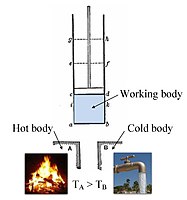
Photo from wikipedia
Abstract Buildings consumed about 30% of total commercial energy and emitted 28% of the CO2 in the world in 2018. A new and effective approach to reduce the energy consumption… Click to show full abstract
Abstract Buildings consumed about 30% of total commercial energy and emitted 28% of the CO2 in the world in 2018. A new and effective approach to reduce the energy consumption and CO2 emission is to develop building envelopes with variable thermo-physical property materials such as phase change materials (PCMs) and/or smart glazing material, so as to make full use of climate resources including solar energy and ambient air temperature variation. However, how do we determine the ideal variable thermo-physical properties of those kinds of building envelope materials? How do we prepare or select the corresponding material accordingly? How do we measure such variable thermo-physical properties in a convenient and economical way? How do we design and apply these building envelopes suitably and effectively? This paper reviews literature studies to answer these questions. The main thread of the review is: (1) to determine the ideal thermo-physical property materials for opaque or transparent building envelopes by an inverse problem-variation solution method; (2) to evaluate methods of selecting or developing practical building envelope materials, especially PCMs, with variable thermo-physical properties accordingly; (3) to compare the DSC, T-history and T-depth methods of measuring thermo-physical properties of opaque building envelope materials; (4) to describe applications of various opaque and transparent variable thermo-physical property building envelopes and heating, ventilating and air-conditioning (HVAC) systems. This review shows that the ideal thermo-physical properties of building envelope materials can best be obtained with the inverse problem-variation solution method. Based on that, variable thermo-physical property materials, including phase change materials, thermochromic /electrochromic/ photochromic smart glazing and heat pipe, can be selected and prepared. Optimal building climate response performance and energy-saving can be achieved by using variable thermo-physical building envelopes. Finally, some problems worthy of future research are presented.
Journal Title: Energy and Buildings
Year Published: 2020
Link to full text (if available)
Share on Social Media: Sign Up to like & get
recommendations!